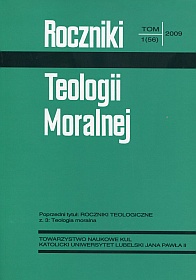Priestly Service in the Sacrament of Penance in the First Centuries of the Church
Abstract
The penance practice of the Church changed during the ages. One of the invariable elements of the sacrament of penance and reconciliation is the service of the dispenser. Particular stages of the canon penance that was the form of celebration of this sacrament in the first centuries of the Church, i.e. entering the state of penitents, the period of penance and reconciliation, had a liturgical character and occurred with the participation of the whole community of the Church. The bishop (and later also the presbyter), who was at the head of the Christian community, made the decision about admitting to the state of penitents, led the penitential rites, heard the confession (if a confession was necessary), determined the way penance was to be performed, as well as its length. In each period of penance the gesture of laying on of hands took place. In that period we find the so-called dispenser's functions defined as the classic ones: he is called the father, teacher, physician and judge. Priestly service in the penance process had an ecclesial character. Excluding someone from the community and admitting him to it anew was an important element of the penance process in that period. An analogy is seen between the catechumenate that prepared one for baptism and introduced him to the Church, and canon penance that was including a sinner into the community of salvation again, as he had been excluded from it because of sin.
References
Jan Paweł II: List apostolski Misericordia Dei o niektórych aspektach sprawowania sakramentu pokuty. Wrocław: TUM 2003 s. 4-5.
Andrzejewski R.: Pokuta w nauczaniu Ojców Kościoła. AK 89:1977 z. 1(411) s.33-46.
Bramorski J.: Wyzwalająca moc pokuty chrześcijańskiej. Studium teologicznomoralne. Pelplin: Bernardinum 2004.
Dallen J.: The Imposition of Hands in Penance: A Study in Liturgical History. „Worship” 51:1977 s. 224-247.
Daquino P.: Il contesto biblico del sacramento della Penitenza. W: La Penitenza. Studi biblici, teologici e pastorali. Il nuovo Rito della Penitenza (Quaderni di Rivista Liturgica n. 9). Torino−Leumann 1989 s. 91-108.
Gerardi R.: Teologia ed etica della penitenza. Bologna: Dehoniane 1993.
Grotz J.: Die Entwicklung des Bußstuffenwesens in der vornicänischen Kirche. Freiburg: Herder 1955
Kwiatkowski K.: Biblijny fundament posługi kapłańskiej w sakramencie pojednania. RT 53:2006 z. 3 s. 39-56.
Loria R.: La Penitenza nei secoli. Excursus storico sull'istituto penitenziale nella Chiesa. W: La Penitenza. Dottrina, Storia, Catechesi e Pastorale (Quaderni di Rivista Liturgica n.3). Torino−Leumann 1967 s. 176-225.
Marella M.: Il ruolo del sacerdote nel sacramento della Penitenza. „Nicolaus” 3:1975 s. 209-227.
Moioli G.: Il quarto sacramento. Note introduttive. Milano: Glossa 1996.
Mokrzycki B.: Kościół w oczyszczeniu. Warszawa: ATK 1986.
Rahner K.: La Penitenza della Chiesa. Saggi storici e teologici. Torino: Ed. Paoline 19923.
Ramos - Regidor J.: Il sacramento della Penitenza. Riflessione teologica biblico-storico-pastorale alla luce del Vaticano II. Torino-Leumann: LDC 19926.
Sesboüé B.: Riconciliati in Cristo. Brescia: Queriniana 1990.
Stanula E.: Katechumenat. EK t. 8 k. 1055-1057.
Vogel C.: Il peccatore e la penitenza nella Chiesa antica. Torino−Leumann: LDC 1967.
Vogel C.: Alienazione del culto nei confronti della comunità cristiana. „Concilium” (wł.) 2:1972 s. 24-40.

